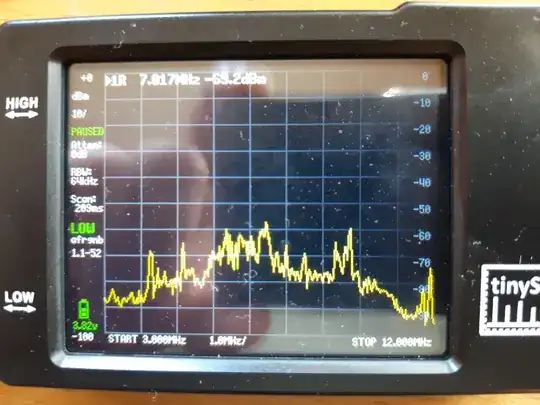This a follow up from this question: QRN: How to chase down a solid S9 noise floor on 40m only
Focusing on how to interpret the signals received with an electrically small, untuned "shielded loop". The following background articles/questions on this type of antenna explain how it works, how not to construct it (eg ARRL 1998), and what it can and cannot do:
http://www.w8ji.com/magnetic_receiving_loops.htm
What does the addition of a shield to a small loop accomplish?
I followed the construction advice in this blog article quite closely, including the use of a pre-amp and a tinySA to amplify and analyse the signal (photos of my implementation in original question)
The core of main challenge, which to find the source of my S8-S9 white noise floor, amounts to these tinySA screenshots.
Elevated noise floor when tinySA connected to my fan dipole:

Signal from the loop when standing under that dipole:

The elevated noise floor is not present. (Note that that I have (hopefully) eliminated conducted noise and feed line shield noise in original question).
So the questions are:
How to interpret the loop signal relative to the dipole?
Why is there no elevated noise floor on the loop?
Is it a matter of sensitivity / level of amplification? The comparative levels of identifiable signals (best reliable example is 7.074MHz FT8) seem to vary with FFT bin width on tinySA. If I scan 7Mhz to 7.2Mhz (as opposed to the wideband 3-12Mhz shown in pics above) which gives me a 3kHz bin width (very similar to LSB bandwidth used for S-level indication of about 2.7kHz) then FT8 is show on tinySA at about -90dBm on the loop after pre-amp (vs S9+20dB on the FT450D meter). The noise floor being about S8 on the radio at that time, would be 26dB down from that and would put it below the noise floor of the tinySA. Yet other information suggests that the loop with a 20dB pre-amp should show similar signal levels to the dipole?
Or are the dipole and the loop just detecting different signals? ie the loop is not seeing the noise floor? Lower height above ground? Near field vs far field debate.. etc.
How can I further narrow this down? ie if I can't see the noise floor with the loop, I can't locate its source and can't hope to eliminate it.
Update 28/4/2021 Further to some very good suggestions from Phil Frost I have carried out some of the tests he suggested. Results below.
Baseline for today (somewhat lower noise yeah! lowest I have ever seen during daytime - slight drizzle outside...) Normal Antenna setup at radio:
FT450D: 7.074Mhz FT8 S9+10 to S9+30 and baseline noise in 40m Band is 6.5S-units
tinySA: on dipole via 22m feedline => 3-12Mhz span base -80dB peaks -50dB
Loop standing under dipole
Direct to tinySA via 10cm feedline => -95dB with peaks to -70dB no raised floor
FT450D via 22m feedline => ft8 S4.5 on radio. Noise floor in Band S0.
TinySA via 22m feedline => -95dB baseline with peaks to -70dB
Dipole fed with short, vertical 5m RG58 feedline into tinySA
tinySA standing under Dipole fed by 5m coax => Very similar to via the 22m feedline -80dB base with peaks to -50dB. Maybe slightly higher (less attenuation?)
Conclusions from these measurements
The raised noise floor is not coming from the feedline. Both the above tests, and earlier tests terminating the feedline at feedpoint (under original question) agree on this.
The raised noise floor is not coming from my rig (FT450D) or anything connected to it, like power supply or ground, because the tinySA fed via 5m short coax standing under dipole produce same results as in shack and as the radio. The is also corroborated by earlier tests in original question, where I ran radio on battery with whole house turned off.
The loop receives far field signals (eg 40m FT8) much more weakly than the dipole. Compare S9+20dB to S4.5 on FT450D via the same 22m feedline. That's a difference of 40dB+. The tinySA shows less of a difference but still 20-30dB. This is true when measured by 10cm coax feedline or via 22m feedline back in shack. The raised noise floor is not visible via the loop, could be because both wanted and unwanted signals are much smaller. Smaller signals could be because:
-
- the loop is lower to the ground / obscured by nearby buildings
-
- the loop has much lower sensitity for which the 20dB preamp cannot compensate
-
- anything else?
It's hard to ascertain where the raised floor is coming from because our loop seems not sensitive enough. Or we need to get it experimentally closer to source of noise by trial and error. (eg area around tips of dipole).
The author of blog article I followed (KA7OEI) for loop construction seems to suggest that from his experience, such a loop with such a pre-amp should give signal strengths roughly comparable to a full size antenna. I tested the pre-amp with AWG and Oscilloscope, so I am pretty confident about that. So either my construction of the loop or some other factor is making my loop much less (20-40dB!) less sensitive than it should be??
-- end of update
Many thanks